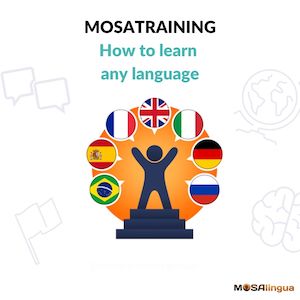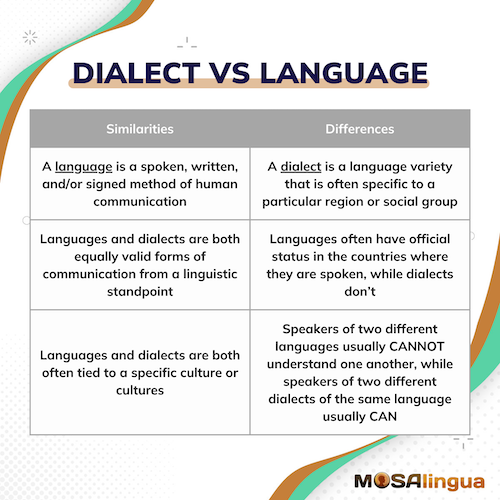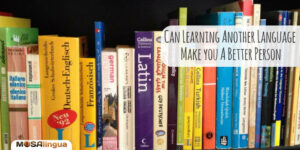Have you ever wondered what the difference is between a dialect vs. a language? There are thousands of languages spoken in the world today, and thousands MORE dialects. Miami English, Cajun English, and California English are just a few of the many dozens of English dialects you’ll hear in the US alone. But what makes a language variety a dialect rather than a language? Today we’ll try to answer this tricky question the best we can. Let’s go!

Same, Same, but Different: Dialect vs. Language
The dialect vs. language debate is a complex and often controversial topic. Contrary to popular belief, there’s not a strict science that separates one from the other. Even linguists don’t have a straightforward definition!
However, there are some general rules we can consider when classifying something as a dialect or a language. Let’s take a look!
Language
The definition of a language is straightforward at first glance.
According to Oxford Languages, a language is “a system of communication used by a particular country or community.” Going even further, Britannica defines language in general as “a system of conventional spoken, manual (signed), or written symbols by means of which human beings, as members of a social group and participants in its culture, express themselves.”
In other words, language refers to a system of verbal and written communication used by a group of people to express ideas, thoughts, and emotions and share information.
Language can have different forms, grammatical structures, vocabulary, and distinct sounds (phonology).
Some languages use a system of writing, while others exist only as spoken languages.
Every language is unique and carries with it a rich culture and a particular way of understanding the world. Thousands of languages exist all over the world, some spoken by millions of people and some with only a handful of speakers left.
Languages are a fundamental aspect of human culture. In fact, they are part of what makes us human!
Dialect
So what is a dialect?
A dialect is defined as a variety of a language that develops in a specific geographical region or inside of a specific community of speakers.
Think of it this way: a language is an umbrella under which many different dialects can fall. ☂️
Dialects are characterized by differences in pronunciation, grammar, vocabulary, and other linguistic aspects in comparison with other varieties of the same language.
Some examples of dialects are Appalachian English, Egyptian Arabic, and Argentinian Spanish.
How do dialects come about? Dialects form thanks to historical, geographical, cultural, and political factors that influence the evolution of a language in different regions or communities. Many dialects have rich literary and cultural traditions, and they offer valuable contributions to the linguistic landscape.
The speakers of different dialects of the same language are often–but not always!–able to understand one another. Think of Brazilian Portuguese vs. European Portuguese. There are some differences in grammar, vocabulary, and accent, but speakers of each dialect can have a conversation fairly easily.
How to learn any language

News flash: those people aren’t any smarter than you are, and they don’t have any kind of special gift for language learning, either. It’s all because of the methods they use. Practicing with the latest and most effective techniques, along with a few expert tips, is a recipe for success.
It can work for you, too! MosaTraining combines all of these tips and techniques into one comprehensive, hands-on approach to language learning.
Mutual intelligibility in dialect vs. language
Sometimes, though, the differences between different dialects can make communication difficult. The more distinct two dialects are, the harder it will be for their speakers to understand each other.
And sometimes, speakers of different dialects of the same language can’t understand each other at all!
For example, Mandarin and Cantonese, two dialects of the Chinese language, are not mutually intelligible. Speakers of Mandarin cannot understand speakers of Cantonese and vice versa.
So why are they classified as the same language?
In the case of Chinese dialects, there are a couple of reasons why they’re all considered the same language. One reason is that they all use the same writing system and have the same historical roots. However, political factors also play a role in the unification of these dialects as one language. Grouping the differing dialects of Chinese under one language umbrella supports China’s strong national identity.
On the other hand, some languages are so similar that you’d guess they were dialects of the same language.
Hindi and Urdu, two of India’s most spoken languages, are so comparable that speakers of the two can generally converse easily. However, political and cultural factors have influenced their spread and development. Urdu, written in an Arabic script, is the main language of the Islamic nation of Pakistan, while Hindi, written in a Devanagari script, is the most spoken language in the Hindu nation of India. So, even if these two languages are so mutually intelligible they’re nearly the same, they’re classified as two separate languages thanks to important cultural differences.
Why does this matter? Well, even though there are certain rules and traits that we can look to when trying to classify a language vs. a dialect, the rules don’t always apply. The concept is slippery and sometimes even fraught.
“A language is a dialect with an army and a navy”
There’s a harmful misconception that dialects are inherently less smart or complex than languages, but that couldn’t be further from the truth. Dialects don’t usually carry the same linguistic prestige that languages do, but that’s not due to any innate qualities that languages have but dialects lack. Rather, it’s due to social, political, and cultural factors.
Maybe you’ve heard the phrase, “A language is just a dialect with an army and a navy.” This is a cheeky way of saying that the difference between a language and a dialect is often power.
Language is a human invention. It’s present in every aspect of our lives; we change language, and it changes us. It’s impossible to separate language from the humans who interact with it. So when culture and politics become involved, the line between language and dialect blurs pretty quickly.
From a linguistic perspective, languages and dialects are both equally valid ways of communication. But it’s usually the language varieties spoken by powerful people that are recognized and classified as a language.
Put another way, that language variety becomes the dominant dialect of a country or region. Other differing varieties of this language are then classified as dialects, and they aren’t usually afforded any official recognition or status.
Dialect vs Language: Fast Facts
As we’ve seen, this topic is far from clear-cut. Let’s summarize the basic differences between a language and a dialect.
A language has the following characteristics:
- Status: A language generally has a higher status than a dialect and is considered an independent entity with its own grammar, vocabulary, and rules of communication. Languages usually have a standardized form used in education and other means of communication.
- Mutual intelligibility: Two speakers of the same language should be able to understand one another without much difficulty, even if they come from different regions within the same country.
- Official recognition: Languages often have official recognition in countries and regions, and can be used in government documents, formal education, and other official fields.
- Significant differences: If there are dialectal variations in a language, those differences are usually relatively minor in comparison with the differences between languages.
On the other hand, a dialect is characterized by these features:
- Regional variety: A dialect is a variety of a language that develops in a specific geographical region. Dialects can differ in pronunciation, grammar, and vocabulary, but they still share enough similarities to be considered part of the same language.
- Variable intelligibility: The speakers of different dialects of the same language can typically understand one another, though it’s not uncommon to have issues with comprehension when two dialects have distinct differences.
- No official recognition: Although some dialects have a rich literary and cultural tradition, they often don’t have official recognition as independent entities.
- Sociocultural aspect: Sociocultural, historical, and geographical factors influence the existence and use of dialects in the communities where they’re spoken.
Summarizing the similarities and differences between languages and dialects
Next Steps
The difference between dialect vs. language is just one example of how fascinating and complex the world of linguistics can be! Both dialects and languages are essential forms of communication. They’re different mostly because of the ways we interact with them. Want to learn more? Check out the articles below!
- Some Obscure but Cool Languages, and How to Learn Them
- The Importance of Body Language for Communication
- Which Language Should I Learn? Pick One of the 7 Most Useful Languages
- What Is the Most Beautiful Language? Is There One, Or Is It All a Myth? 🤨

![How to Improve Your Listening Skills [VIDEO]](https://www.mosalingua.com/en/files/2016/12/1-768x432-300x169.jpg)



Comments